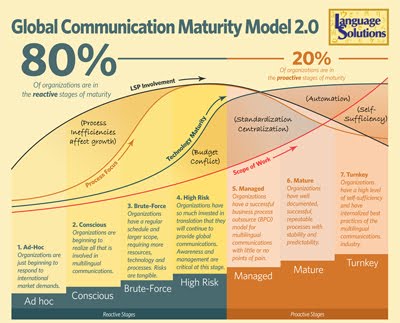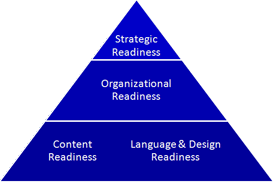During a consultation with one of our clients, the question that came to the table was how to measure the impact of culture on HR communications for one of their clients. This conversation gave us a good opportunity to present our metric around cultural distances and how it can impact your business case for translating for a particular market.
There are many leading indicators for building a business case, but generally there are two decisions to be made:
1. Do you translate for a particular market, and in what language(s)?
2. Do you internationalize or localize for a particular market?
The first point deals with the language of the communication; the second with the cultural distance of the target market as compared with the domestic country of the client as a leading indicator to support this decision. Both of these factors can have a great impact on the effectiveness of the communication, but the second decision was the most important for our client to quantify and to be able to tie into the strategic outcome of the end client's business.
In the proposal meeting, we were able to provide our methodology for measuring the impact of culture on the effectiveness of communications. The measure is built around a couple of key cultural dimensions and the ranking of each target market on that value based on the value as measured in the domestic country (in this case the US). The cultural distance metric ranks how far target markets are culturally removed from their client's domestic country. The metric also gives good insight as to how cultures of different target markets correlate. This would determine whether the messaging needs to be edited for an international audience (internationalize), for a particular region (regionalize) or customized for the particular market (localize).
This metric fits very well with our strategic partner, an HR Global Consulting Firm, who can do further research towards each cultural dimension and relate it to the cultural values that are present in many corporate communications. With this metric, a more informed decision can made towards a directive for localization. We will continue to bring this metric into further practice with our clients and report about the results.
Tuesday, September 9, 2008
Leading Indicators for Building a Business Case to translate for a particular market
share on LinkedIn
share on Facebook
share on Twitter
Labels:
cultural dimensions,
cultural distance,
internationalize,
language solutions,
leading indicators,
localize,
metrics,
regionalize
Too much focus on lagging measures
A number of factors affect an organization’s position on the Global Communication Maturity Model™ (GCMM). In organizations that are just beginning to respond to international marketing demands, process management efficiencies are usually driven at the operational level. Upper management in organizations at the Reactive and Conscious levels rarely drive process management initiatives. As companies mature, the strategic top is increasingly involved in and focused on process management because their global communication endeavors have a bigger impact on the overall success of the company.
Innovation usually finds its roots at the operational level. How can lower and middle management help to innovate in process efficiency for global communications? How is their contribution to the overall success of the company validated?
The position that an organization is in on the GCMM is indeed a lagging indicator. Too many organizations focus on the lagging measures such as profit, ROI, etc. Those are the existing metrics currently in our industry. Metrics are critical to global thinking, but failing to measure the right things can lead one off the path. Language Service providers in our industry have plenty of metrics, especially TM (Translation Memory) leverage percentages. However, global organizations need to look at the leading indicators that influence and forecast the amount of leverage an organization can get from their TM. Those leading indicators need to be aligned with the people in the organization that impact those measures. At Language Solutions, we help organizations to tie key objectives to people and processes within their organization, providing insight on accountability and decision support.
Innovation usually finds its roots at the operational level. How can lower and middle management help to innovate in process efficiency for global communications? How is their contribution to the overall success of the company validated?
The position that an organization is in on the GCMM is indeed a lagging indicator. Too many organizations focus on the lagging measures such as profit, ROI, etc. Those are the existing metrics currently in our industry. Metrics are critical to global thinking, but failing to measure the right things can lead one off the path. Language Service providers in our industry have plenty of metrics, especially TM (Translation Memory) leverage percentages. However, global organizations need to look at the leading indicators that influence and forecast the amount of leverage an organization can get from their TM. Those leading indicators need to be aligned with the people in the organization that impact those measures. At Language Solutions, we help organizations to tie key objectives to people and processes within their organization, providing insight on accountability and decision support.
Subscribe to:
Posts (Atom)










